1997 SSANGYONG KORANDO section 2c
[x] Cancel search: section 2cPage 1523 of 2053
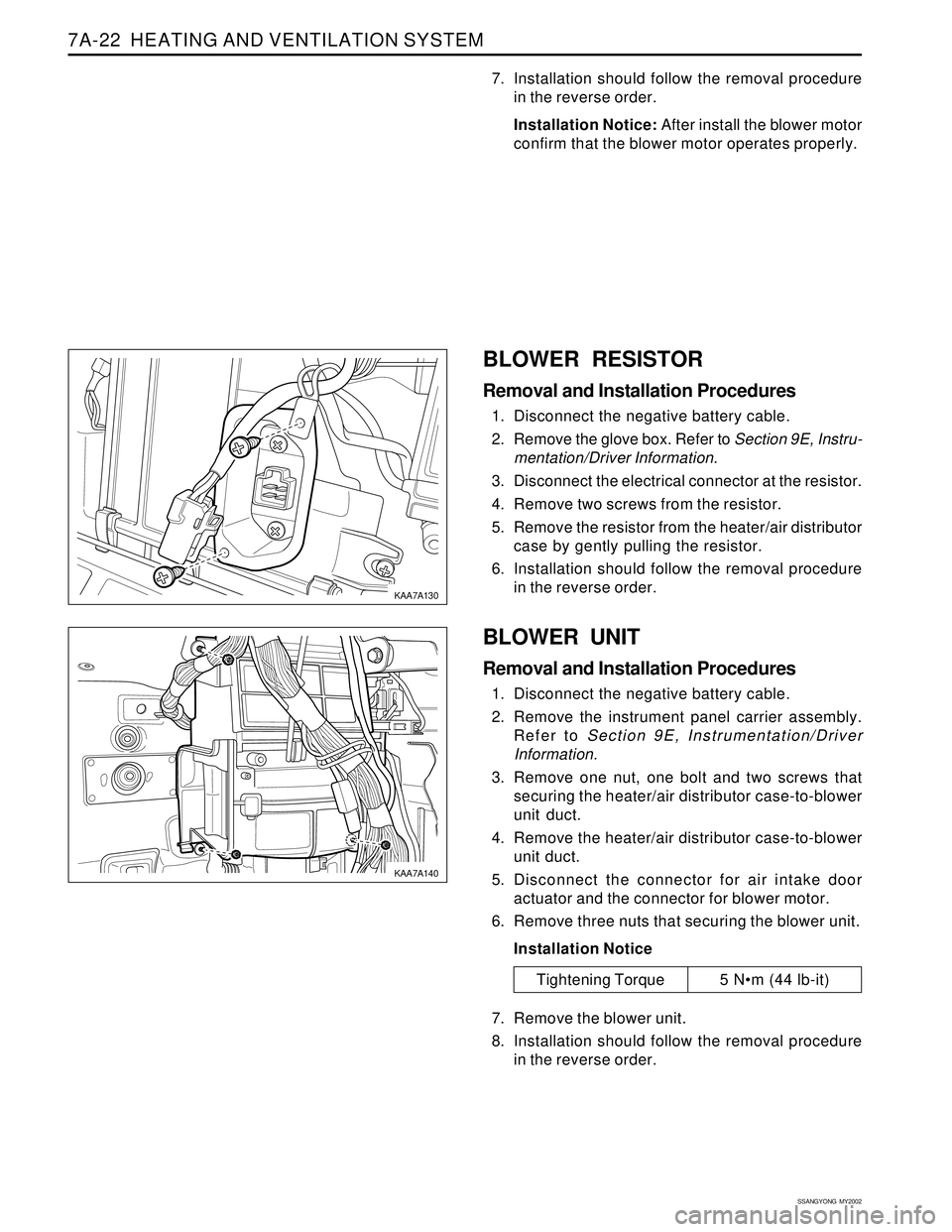
SSANGYONG MY2002
7A-22 HEATING AND VENTILATION SYSTEM
7. Installation should follow the removal procedure
in the reverse order.
Installation Notice: After install the blower motor
confirm that the blower motor operates properly.
KAA7A130
KAA7A140
BLOWER RESISTOR
Removal and Installation Procedures
1. Disconnect the negative battery cable.
2. Remove the glove box. Refer to Section 9E, Instru-
mentation/Driver Information.
3. Disconnect the electrical connector at the resistor.
4. Remove two screws from the resistor.
5. Remove the resistor from the heater/air distributor
case by gently pulling the resistor.
6. Installation should follow the removal procedure
in the reverse order.
BLOWER UNIT
Removal and Installation Procedures
1. Disconnect the negative battery cable.
2. Remove the instrument panel carrier assembly.
Refer to Section 9E, Instrumentation/Driver
Information.
3. Remove one nut, one bolt and two screws that
securing the heater/air distributor case-to-blower
unit duct.
4. Remove the heater/air distributor case-to-blower
unit duct.
5. Disconnect the connector for air intake door
actuator and the connector for blower motor.
6. Remove three nuts that securing the blower unit.
Installation Notice
7. Remove the blower unit.
8. Installation should follow the removal procedure
in the reverse order.
Tightening Torque 5 Nm (44 lb-it)
Page 1524 of 2053
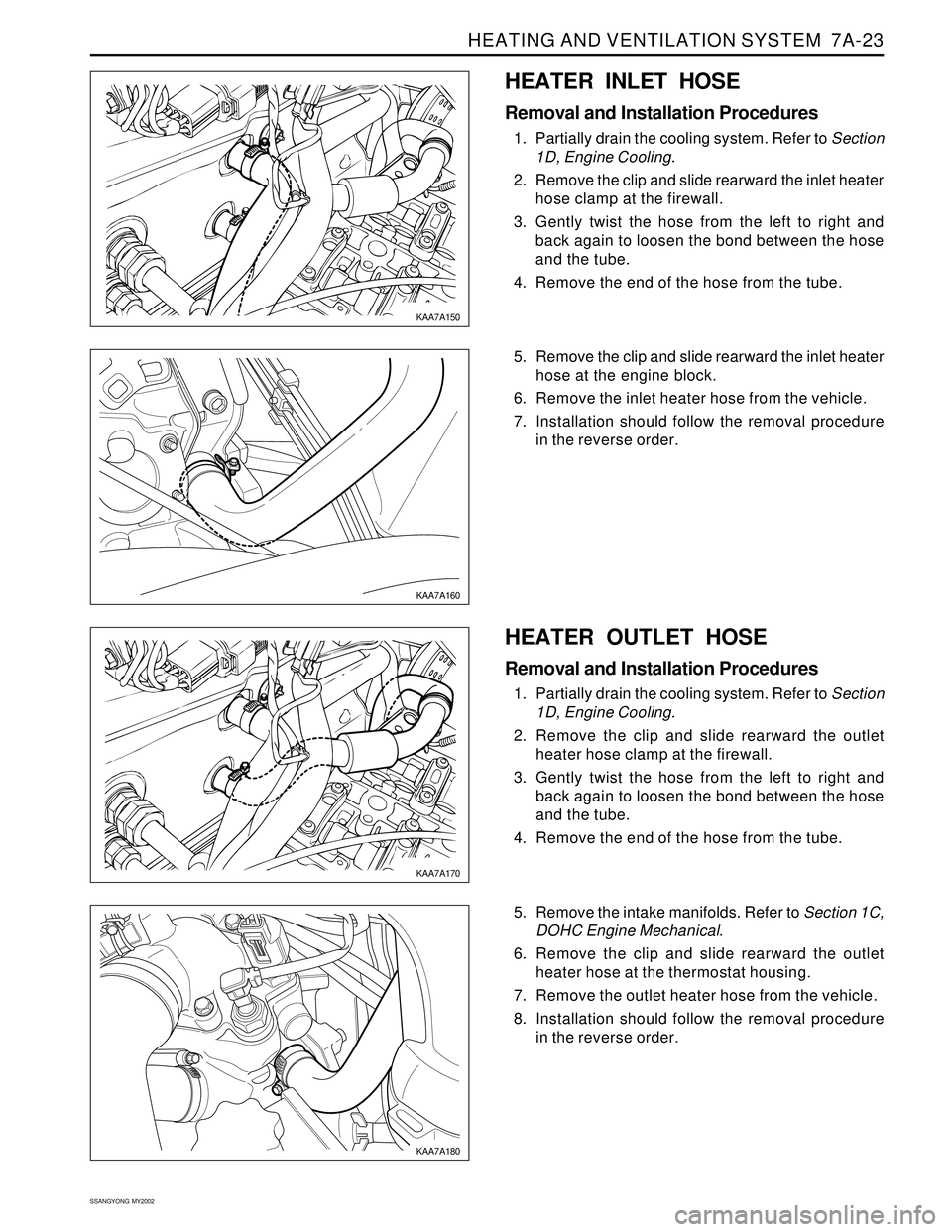
HEATING AND VENTILATION SYSTEM 7A-23
SSANGYONG MY2002
HEATER INLET HOSE
Removal and Installation Procedures
1. Partially drain the cooling system. Refer to Section
1D, Engine Cooling.
2. Remove the clip and slide rearward the inlet heater
hose clamp at the firewall.
3. Gently twist the hose from the left to right and
back again to loosen the bond between the hose
and the tube.
4. Remove the end of the hose from the tube.
KAA7A150
KAA7A160
KAA7A170
KAA7A180
5. Remove the clip and slide rearward the inlet heater
hose at the engine block.
6. Remove the inlet heater hose from the vehicle.
7. Installation should follow the removal procedure
in the reverse order.
HEATER OUTLET HOSE
Removal and Installation Procedures
1. Partially drain the cooling system. Refer to Section
1D, Engine Cooling.
2. Remove the clip and slide rearward the outlet
heater hose clamp at the firewall.
3. Gently twist the hose from the left to right and
back again to loosen the bond between the hose
and the tube.
4. Remove the end of the hose from the tube.
5. Remove the intake manifolds. Refer to Section 1C,
DOHC Engine Mechanical.
6. Remove the clip and slide rearward the outlet
heater hose at the thermostat housing.
7. Remove the outlet heater hose from the vehicle.
8. Installation should follow the removal procedure
in the reverse order.
Page 1525 of 2053
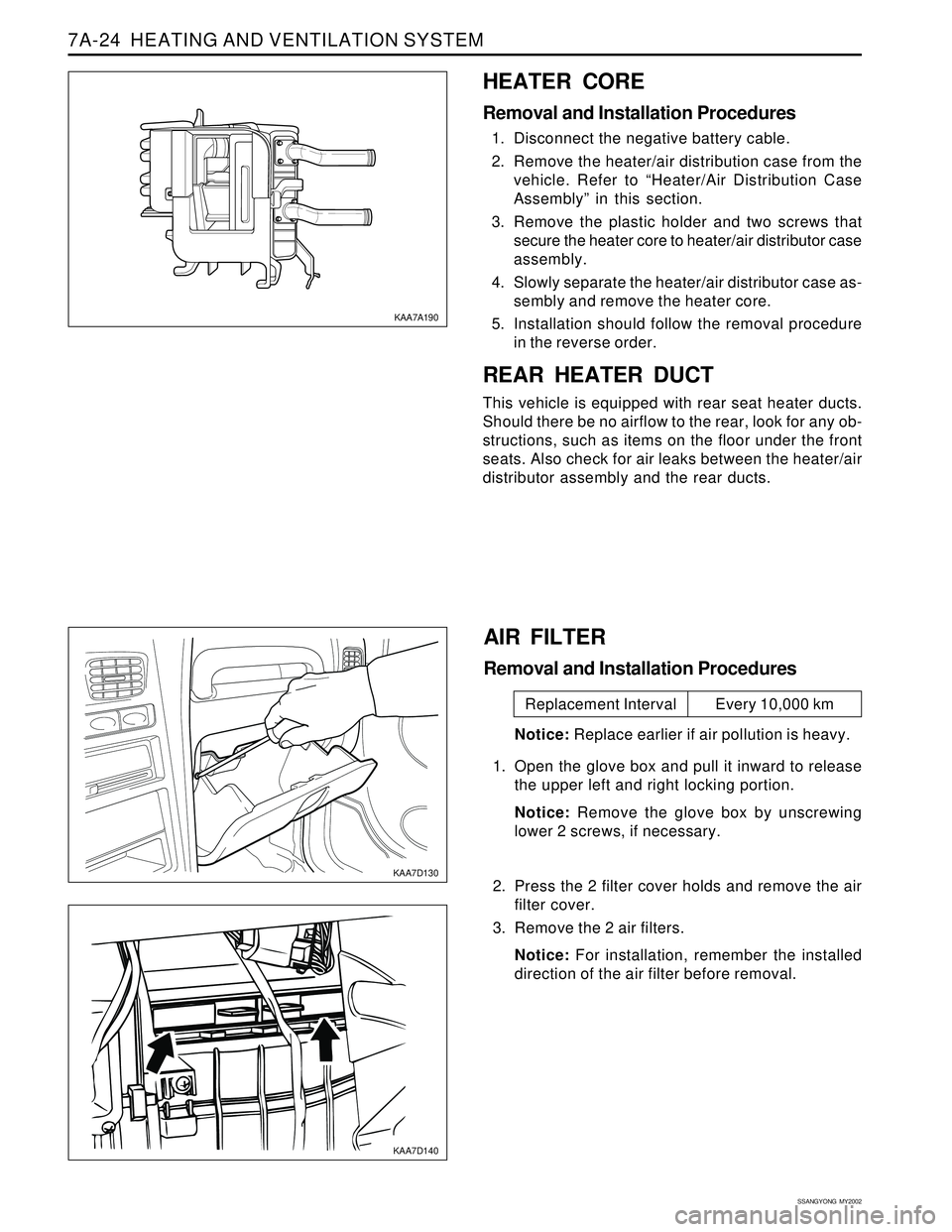
SSANGYONG MY2002
7A-24 HEATING AND VENTILATION SYSTEM
HEATER CORE
Removal and Installation Procedures
1. Disconnect the negative battery cable.
2. Remove the heater/air distribution case from the
vehicle. Refer to “Heater/Air Distribution Case
Assembly” in this section.
3. Remove the plastic holder and two screws that
secure the heater core to heater/air distributor case
assembly.
4. Slowly separate the heater/air distributor case as-
sembly and remove the heater core.
5. Installation should follow the removal procedure
in the reverse order.
REAR HEATER DUCT
This vehicle is equipped with rear seat heater ducts.
Should there be no airflow to the rear, look for any ob-
structions, such as items on the floor under the front
seats. Also check for air leaks between the heater/air
distributor assembly and the rear ducts.
KAA7A190
KAA7D130
KAA7D140
AIR FILTER
Removal and Installation Procedures
Notice: Replace earlier if air pollution is heavy.
1. Open the glove box and pull it inward to release
the upper left and right locking portion.
Notice: Remove the glove box by unscrewing
lower 2 screws, if necessary.
2. Press the 2 filter cover holds and remove the air
filter cover.
3. Remove the 2 air filters.
Notice: For installation, remember the installed
direction of the air filter before removal.
Replacement Interval Every 10,000 km
Page 1530 of 2053
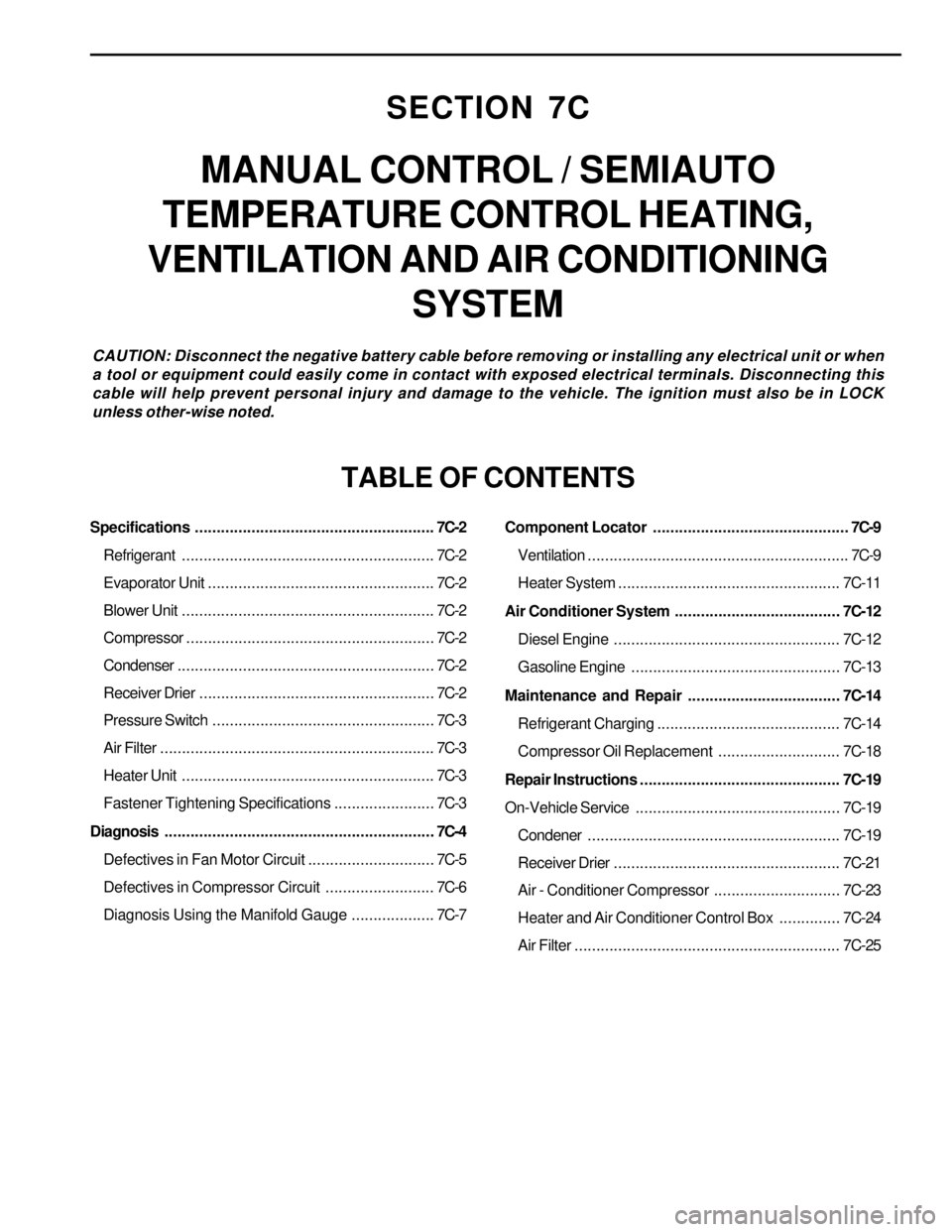
SECTION 7C
MANUAL CONTROL / SEMIAUTO
TEMPERATURE CONTROL HEATING,
VENTILATION AND AIR CONDITIONING
SYSTEM
CAUTION: Disconnect the negative battery cable before removing or installing any electrical unit or when
a tool or equipment could easily come in contact with exposed electrical terminals. Disconnecting this
cable will help prevent personal injury and damage to the vehicle. The ignition must also be in LOCK
unless other-wise noted.
TABLE OF CONTENTS
Specifications.......................................................7C-2
Refrigerant..........................................................7C-2
Evaporator Unit....................................................7C-2
Blower Unit..........................................................7C-2
Compressor.........................................................7C-2
Condenser...........................................................7C-2
Receiver Drier......................................................7C-2
Pressure Switch...................................................7C-3
Air Filter...............................................................7C-3
Heater Unit..........................................................7C-3
Fastener Tightening Specifications.......................7C-3
Diagnosis..............................................................7C-4
Defectives in Fan Motor Circuit.............................7C-5
Defectives in Compressor Circuit.........................7C-6
Diagnosis Using the Manifold Gauge...................7C-7Component Locator.............................................7C-9
Ventilation............................................................7C-9
Heater System ................................................... 7C-11
Air Conditioner System...................................... 7C-12
Diesel Engine .................................................... 7C-12
Gasoline Engine................................................ 7C-13
Maintenance and Repair................................... 7C-14
Refrigerant Charging .......................................... 7C-14
Compressor Oil Replacement............................ 7C-18
Repair Instructions.............................................. 7C-19
On-Vehicle Service............................................... 7C-19
Condener.......................................................... 7C-19
Receiver Drier.................................................... 7C-21
Air - Conditioner Compressor............................. 7C-23
Heater and Air Conditioner Control Box.............. 7C-24
Air Filter............................................................. 7C-25
Page 1555 of 2053
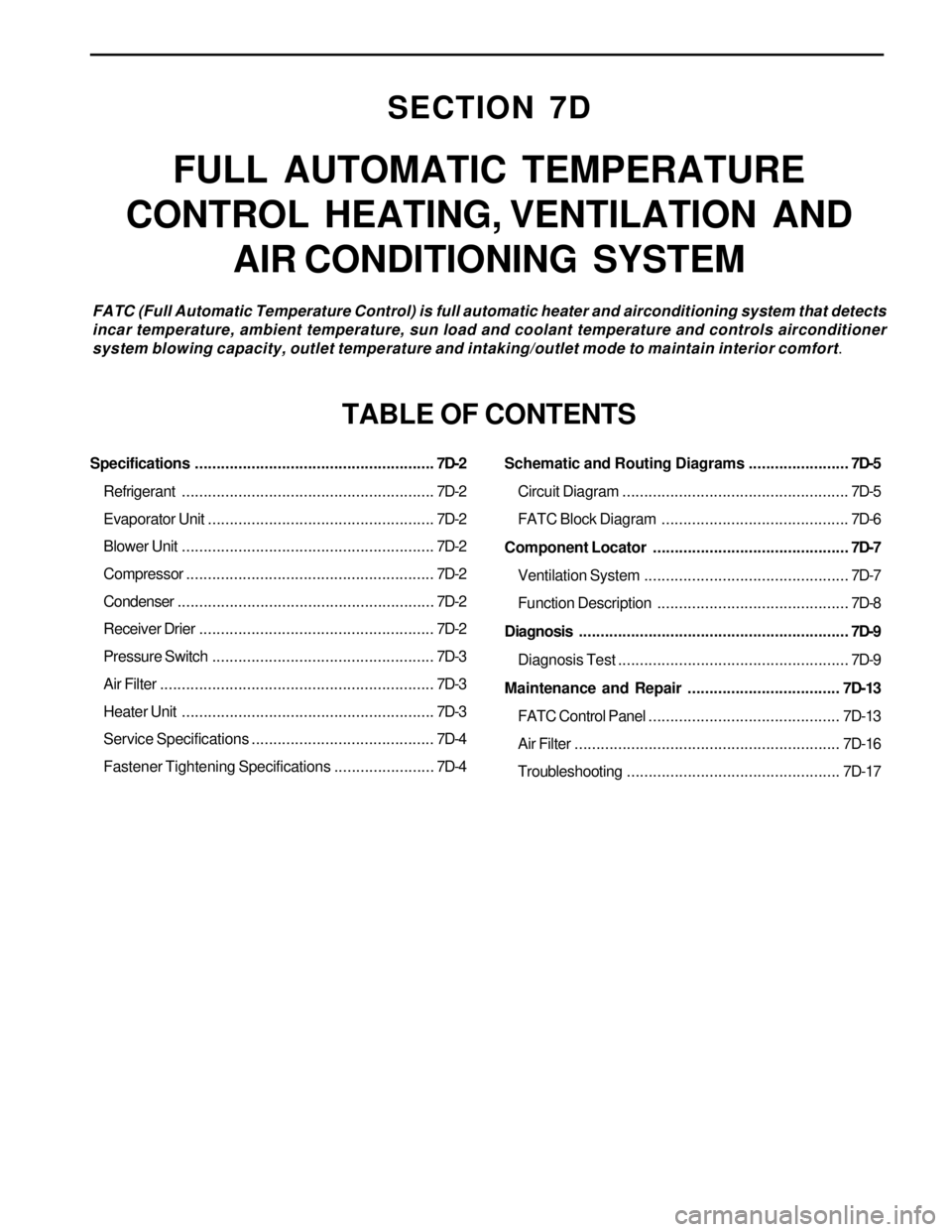
SECTION 7D
FULL AUTOMATIC TEMPERATURE
CONTROL HEATING, VENTILATION AND
AIR CONDITIONING SYSTEM
FATC (Full Automatic Temperature Control) is full automatic heater and airconditioning system that detects
incar temperature, ambient temperature, sun load and coolant temperature and controls airconditioner
system blowing capacity, outlet temperature and intaking/outlet mode to maintain interior comfort.
TABLE OF CONTENTS
Specifications.......................................................7D-2
Refrigerant..........................................................7D-2
Evaporator Unit....................................................7D-2
Blower Unit..........................................................7D-2
Compressor.........................................................7D-2
Condenser...........................................................7D-2
Receiver Drier......................................................7D-2
Pressure Switch...................................................7D-3
Air Filter...............................................................7D-3
Heater Unit..........................................................7D-3
Service Specifications ..........................................7D-4
Fastener Tightening Specifications.......................7D-4Schematic and Routing Diagrams.......................7D-5
Circuit Diagram....................................................7D-5
FATC Block Diagram...........................................7D-6
Component Locator.............................................7D-7
Ventilation System...............................................7D-7
Function Description............................................7D-8
Diagnosis..............................................................7D-9
Diagnosis Test.....................................................7D-9
Maintenance and Repair................................... 7D-13
FATC Control Panel............................................ 7D-13
Air Filter............................................................. 7D-16
Troubleshooting................................................. 7D-17
Page 1558 of 2053
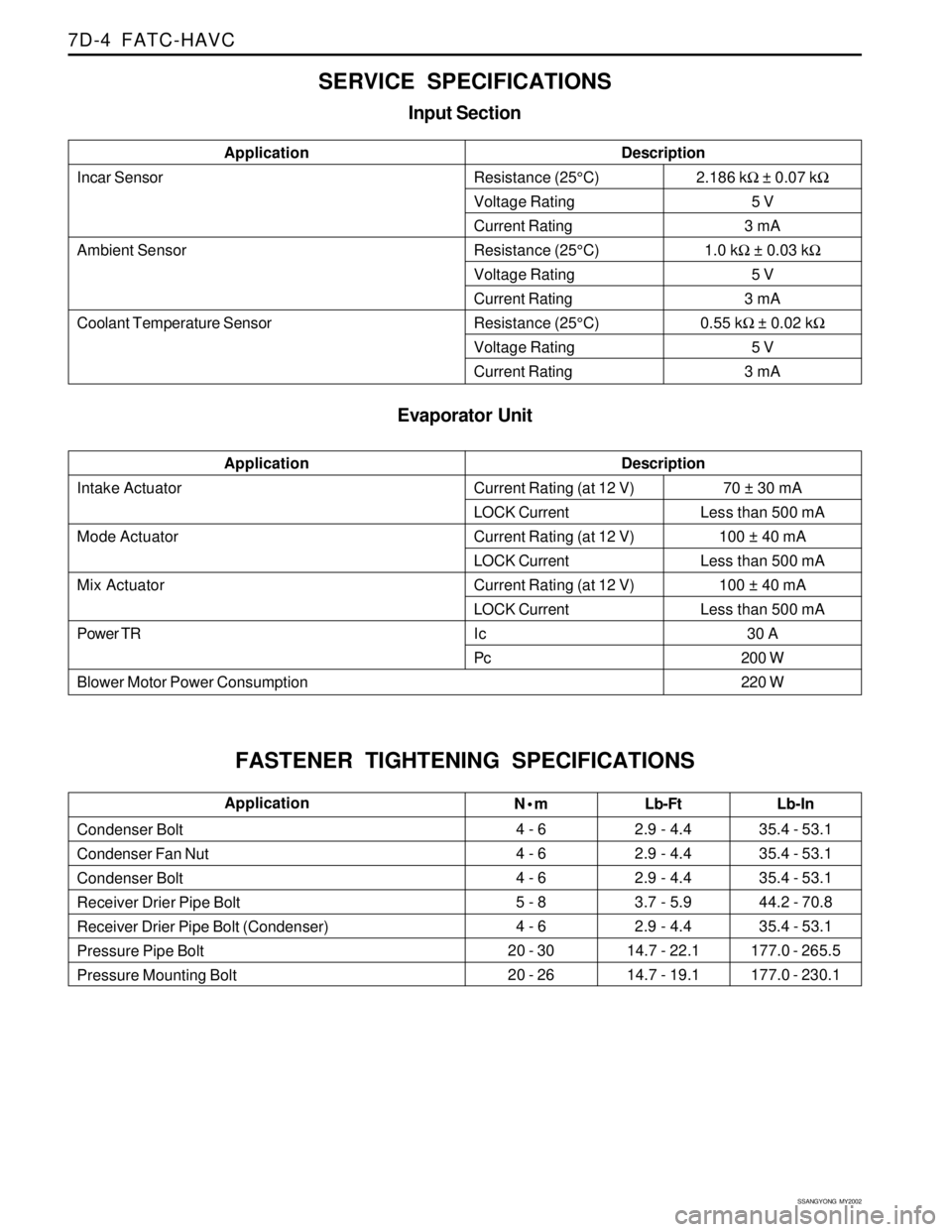
SSANGYONG MY2002
7D-4 FATC-HAVC
SERVICE SPECIFICATIONS
Input Section
Incar Sensor
Ambient Sensor
Coolant Temperature SensorApplicationDescriptionResistance (25°C)
Voltage Rating
Current Rating
Resistance (25°C)
Voltage Rating
Current Rating
Resistance (25°C)
Voltage Rating
Current Rating
Evaporator Unit
2.186 kΩ ± 0.07 kΩ
5 V
3 mA
1.0 kΩ ± 0.03 kΩ
5 V
3 mA
0.55 kΩ ± 0.02 kΩ
5 V
3 mA
Intake Actuator
Mode Actuator
Mix Actuator
Power TR
Blower Motor Power ConsumptionApplicationDescriptionCurrent Rating (at 12 V)
LOCK Current
Current Rating (at 12 V)
LOCK Current
Current Rating (at 12 V)
LOCK Current
Ic
Pc70 ± 30 mA
Less than 500 mA
100 ± 40 mA
Less than 500 mA
100 ± 40 mA
Less than 500 mA
30 A
200 W
220 W
FASTENER TIGHTENING SPECIFICATIONS
N•m
4 - 6
4 - 6
4 - 6
5 - 8
4 - 6
20 - 30
20 - 26Lb-Ft
2.9 - 4.4
2.9 - 4.4
2.9 - 4.4
3.7 - 5.9
2.9 - 4.4
14.7 - 22.1
14.7 - 19.1 Condenser Bolt
Condenser Fan Nut
Condenser Bolt
Receiver Drier Pipe Bolt
Receiver Drier Pipe Bolt (Condenser)
Pressure Pipe Bolt
Pressure Mounting BoltLb-In
35.4 - 53.1
35.4 - 53.1
35.4 - 53.1
44.2 - 70.8
35.4 - 53.1
177.0 - 265.5
177.0 - 230.1Application
Page 1577 of 2053
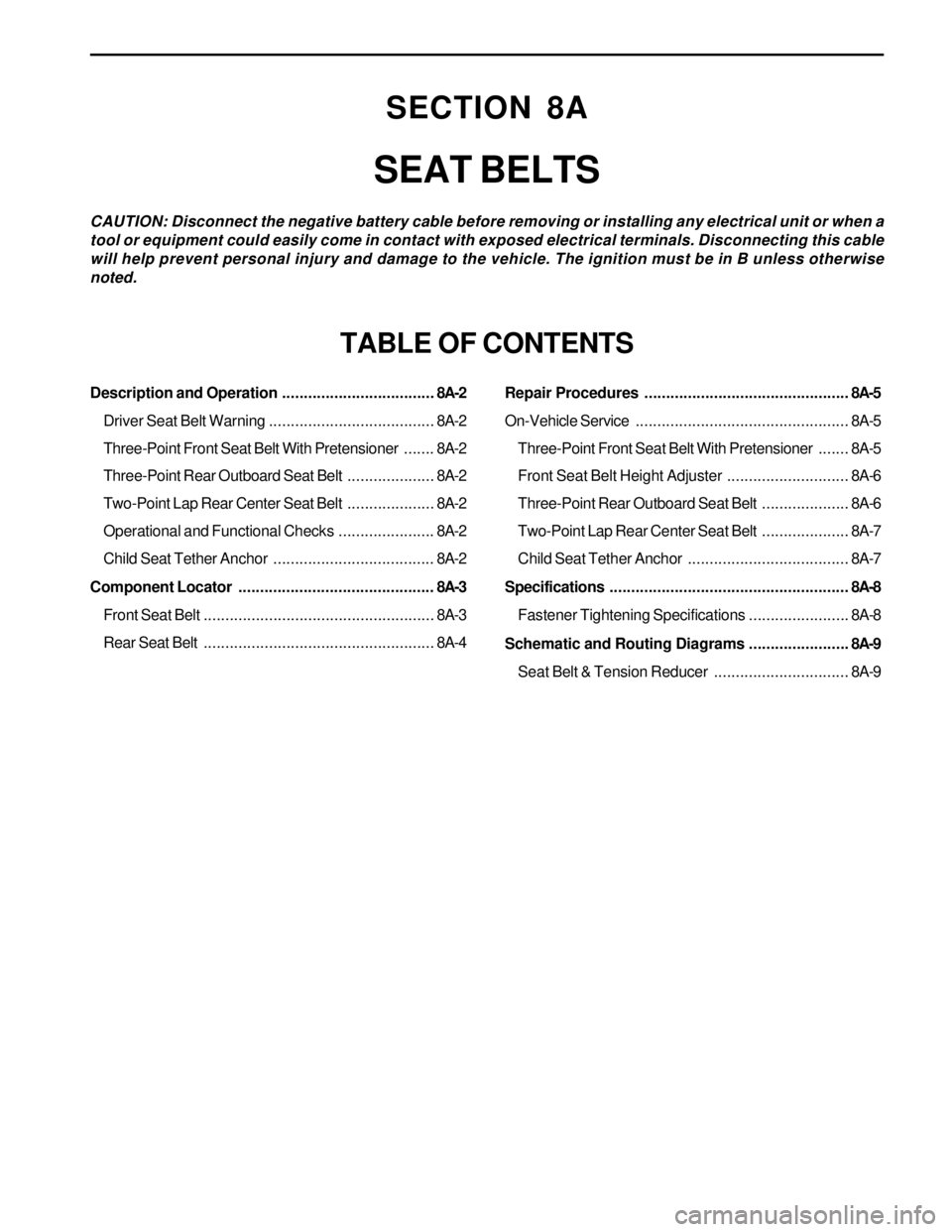
SECTION 8A
SEAT BELTS
CAUTION: Disconnect the negative battery cable before removing or installing any electrical unit or when a
tool or equipment could easily come in contact with exposed electrical terminals. Disconnecting this cable
will help prevent personal injury and damage to the vehicle. The ignition must be in B unless otherwise
noted.
TABLE OF CONTENTS
Description and Operation...................................8A-2
Driver Seat Belt Warning......................................8A-2
Three-Point Front Seat Belt With Pretensioner.......8A-2
Three-Point Rear Outboard Seat Belt....................8A-2
Two-Point Lap Rear Center Seat Belt....................8A-2
Operational and Functional Checks......................8A-2
Child Seat Tether Anchor.....................................8A-2
Component Locator.............................................8A-3
Front Seat Belt.....................................................8A-3
Rear Seat Belt.....................................................8A-4Repair Procedures...............................................8A-5
On-Vehicle Service.................................................8A-5
Three-Point Front Seat Belt With Pretensioner.......8A-5
Front Seat Belt Height Adjuster............................8A-6
Three-Point Rear Outboard Seat Belt....................8A-6
Two-Point Lap Rear Center Seat Belt....................8A-7
Child Seat Tether Anchor.....................................8A-7
Specifications.......................................................8A-8
Fastener Tightening Specifications.......................8A-8
Schematic and Routing Diagrams.......................8A-9
Seat Belt & Tension Reducer...............................8A-9
Page 1578 of 2053
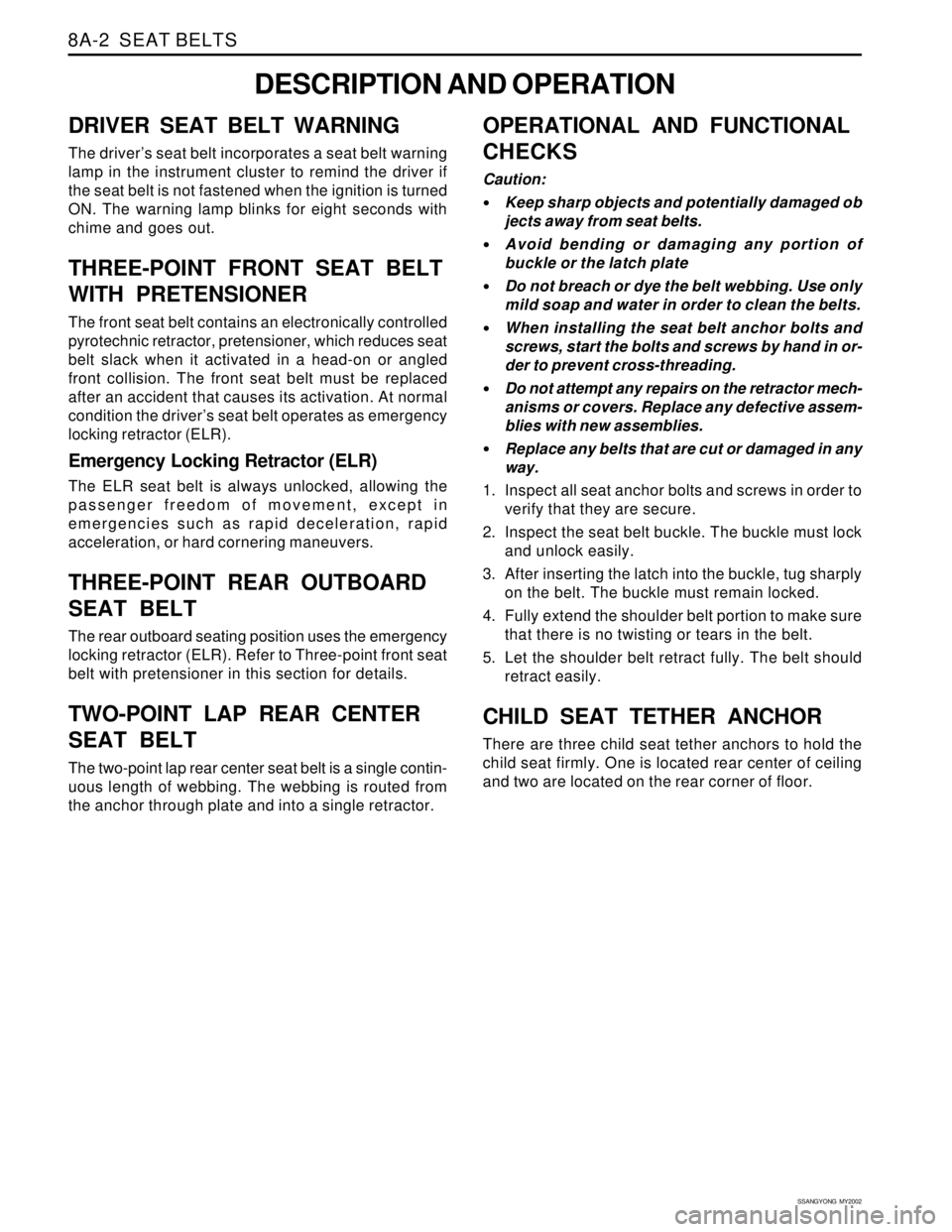
SSANGYONG MY2002
8A-2 SEAT BELTS
DESCRIPTION AND OPERATION
DRIVER SEAT BELT WARNING
The driver’s seat belt incorporates a seat belt warning
lamp in the instrument cluster to remind the driver if
the seat belt is not fastened when the ignition is turned
ON. The warning lamp blinks for eight seconds with
chime and goes out.
THREE-POINT FRONT SEAT BELT
WITH PRETENSIONER
The front seat belt contains an electronically controlled
pyrotechnic retractor, pretensioner, which reduces seat
belt slack when it activated in a head-on or angled
front collision. The front seat belt must be replaced
after an accident that causes its activation. At normal
condition the driver’s seat belt operates as emergency
locking retractor (ELR).
Emergency Locking Retractor (ELR)
The ELR seat belt is always unlocked, allowing the
passenger freedom of movement, except in
emergencies such as rapid deceleration, rapid
acceleration, or hard cornering maneuvers.
THREE-POINT REAR OUTBOARD
SEAT BELT
The rear outboard seating position uses the emergency
locking retractor (ELR). Refer to Three-point front seat
belt with pretensioner in this section for details.
TWO-POINT LAP REAR CENTER
SEAT BELT
The two-point lap rear center seat belt is a single contin-
uous length of webbing. The webbing is routed from
the anchor through plate and into a single retractor.
OPERATIONAL AND FUNCTIONAL
CHECKS
Caution:
Keep sharp objects and potentially damaged ob
jects away from seat belts.
Avoid bending or damaging any portion of
buckle or the latch plate
Do not breach or dye the belt webbing. Use only
mild soap and water in order to clean the belts.
When installing the seat belt anchor bolts and
screws, start the bolts and screws by hand in or-
der to prevent cross-threading.
Do not attempt any repairs on the retractor mech-
anisms or covers. Replace any defective assem-
blies with new assemblies.
Replace any belts that are cut or damaged in any
way.
1. Inspect all seat anchor bolts and screws in order to
verify that they are secure.
2. Inspect the seat belt buckle. The buckle must lock
and unlock easily.
3. After inserting the latch into the buckle, tug sharply
on the belt. The buckle must remain locked.
4. Fully extend the shoulder belt portion to make sure
that there is no twisting or tears in the belt.
5. Let the shoulder belt retract fully. The belt should
retract easily.
CHILD SEAT TETHER ANCHOR
There are three child seat tether anchors to hold the
child seat firmly. One is located rear center of ceiling
and two are located on the rear corner of floor.